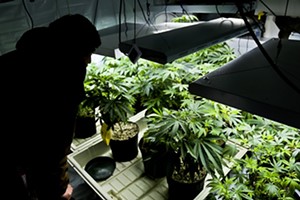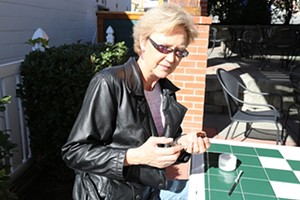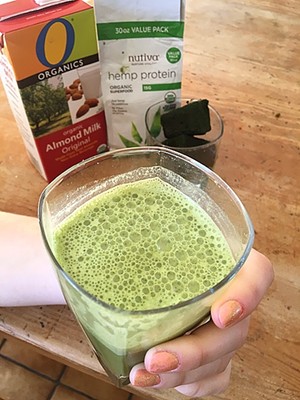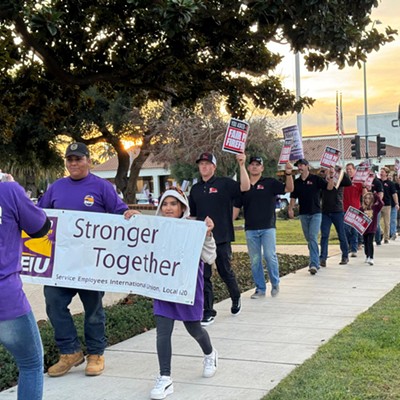Sixteen months ago, Kate Kytle received a grim diagnosis—she had an aggressive form of breast cancer already in the late stages that had spread into her lungs. She was told she only had 18 months to two years to live.
With two to eight months left to go, she arrived at a deli patio in Arroyo Grande with a gust of energy, sat down on a picnic table, and pulled out the medicine that’s been at the forefront of keeping her alive.
It wasn’t an ominous cluster of orange pill bottles. Instead, she had a set of homemade herbal remedies—a green salve in an unmarked white plastic container; a small clear canister holding a potent, thick green oily tincture; and a syringe, without a needle, holding an even a more potent, thick oily substance.
“I don’t like to have this out too much in public,” she said about the syringe.

Although Kytle was uncomfortable about having all her medicine out in public, she wasn’t shy about what it was, how it’s helped her, and how she wants to incorporate it into a future career.
All three concoctions were some form of medical marijuana extract, commonly called concentrated cannabis. They contained high amounts of cannabidiol, or CBD, one of the prominent, medicinal compounds in marijuana. CBD is increasingly regarded for its potent medical applications, and it doesn’t get you high, unlike marijuana’s other prominent and well-known compound, tetrahydrocannabinol, or THC.
Kytle, who has an associate degree in gerontology and is close to another degree in nutrition, works with her caregiver, who grows several plants somewhere in the unincorporated area of the county, to produce certain types of marijuana that are high in CBD and low in THC. She’ll make a concentrate out of those plants using methods with low enough temperatures to retain the medical benefits of the CBD and minimize the psychoactive effects of the THC.
The end results are a salve that she applies topically to her breast twice a day; a tincture with slightly reduced potency that she’ll drink in a tea in the morning; and the high potency oil, kept in a syringe for measurement purposes, that she administers through a suppository, which allows the medicine to be absorbed much more efficiently and reduces the unwanted “high” feeling.
Kytle doesn’t like being high, she said, adding that before she started using cannabis medicinally, she smoked only about six times in the last 20 years.
When she first started using the medicine in heavy doses almost a year and a half ago, Kytle said that the effects were strong and took a few months to get used to. But she knew right away that it was the path to take, rather than the other option, which involved a choice between two different forms of chemotherapy, neither of which she said had been proven to be particularly effective for her diagnosis of Stage IV metastatic triple negative breast cancer.
“I didn’t see any reason to be sick if I only had two years to live,” Kytle said. “I wanted quality of life over quantity of life.”
Kytle was again diagnosed with an aggressive cancer, this time with HER2-positive breast cancer, found in July 2015. She continued use of the CBD oil—which she said doesn’t necessarily cure cancer, but it helps minimize and mitigate it—and is also using the drugs Herceptin and Perjeta, which are antibody therapies that fight cancer using different methods than chemotherapy.
Within five weeks of treatment, a scan showed that her lymph nodes were clear and that the tumors were basically gone.
“It’s amazing what happened,” Kytle said. “It literally stopped my cancer from spreading.”
Kytle, 56, said that through her healing process, she’s also been able to help her caregiver, who’s fighting squamous cell carcinoma that has moved to his lungs. Through the use of a concentrate she’s made for him, she said his tumors have shrunk by two-thirds.
Kytle said that she’s fortunate to have such a productive relationship with a small-scale grower, because it’s also saved her a lot of money. When she first started using medical cannabis, it was costing her upwards of $1,200 a month, which ultimately drained all her financial resources.
Now, Kytle and her caregiver would like to do more. She’s interested in applying both her own experience and knowledge as a nutritionist to play a more active role in producing medicine for others.
“I’m really passionate in helping people with this,” Kytle said. “As a nutritionist, I think this is part of an overall health plan for people.”
Those plans, however, are on hold, in part because recently passed state laws put a wave of local regulations in motion that will ban or restrict the cultivation of medical marijuana in cities and the unincorporated areas. Those policies—which are hurriedly being passed to beat a March 1 deadline and may or may not be permanent—are bringing significant scrutiny from those the in the medical marijuana industry and the patients who rely on it.
A dated mistake
In October 2015, Gov. Jerry Brown signed a set of laws that many say will bring the state into a new era of medical marijuana policy.
The three bills that make up the Medical Marijuana Regulation and Safety Act (MMRSA)—AB 266, AB 243, and SB 643—each make up several pieces of a hefty regulatory framework for the state’s multibillion-dollar medical marijuana industry.
The laws will require state-issued licenses for all aspects of the industry, including propagating, cultivating, manufacturing, testing, distribution, delivering, and retail sale. A new state agency will be created—the Bureau of Medical Marijuana Regulation, or BMMR—and several existing agencies will participate in licensing, monitoring, and regulating the industry.
The law will go into full effect on Jan. 1, 2018, allowing state and local agencies two years to prepare regulatory structures. Operators will be required to obtain a state license. The new licensing scheme will turn an industry largely comprised of collectives—in which the legal rights of patients and caregivers to possess and grow medical cannabis are pooled together—into one comprised of more traditional business models.
Already, there are two major pieces to the laws that are complicating life for both local policymakers and those in the industry.

First, an applicant must get some sort of local authorization, like a permit or a business license, in order to get a state license.
That requirement is concerning people in the local industry who have spent years navigating and adapting to rather prohibitive local approaches to medical marijuana—starting with coordinated raids as the industry began to develop, and, more recently, strict zoning and land-use rules. No cities will permit a brick-and-mortar dispensary, and the county has shot down a handful of applicants; some cities have banned mobile delivery services and few will issue business licenses to mobile dispensaries; and grows have endured sporadic complaints and regulatory changes.
Most growers have yet to obtain formal authorization.
Second, a stipulation in one of the laws says that local governments must have some sort of regulatory framework, like an ordinance, in place by March 1, 2016, in order to maintain control over cultivation.
In response, every single city in Northern Santa Barbara County and SLO County has approved or is currently considering a ban. Several city officials have said there was no opportunity to do otherwise because it would have taken too long to hash out guidelines for cultivation.
In December, Paso Robles Community Development Director Warren Frace told the Sun that meeting the deadline is the first step, and it will be up to the City Council as to whether they want to go back and create more permissive regulations down the road.
“We know this is an issue that’s going to continue to evolve,” Frace said. “We’re trying to comply with the state deadline and make sure we have the ability to maintain local control.”
But that March 1 deadline was a mistake.
Assemblymember Jim Wood, author of AB 243, the bill in question, caught the mistake immediately after the law passed and pledged to introduce cleanup legislation as soon as the Legislature went into session this year. On Jan. 4, Paul Ramey, a spokesperson for Wood, said amendments were submitted at the first possible opportunity.
Still, cities that have charted a course toward an outright ban continue to move forward undeterred.
Paso Robles City Councilmember Fred Strong, who’s intimately involved with the California League of Cities, which firmly lobbied for the local control provision, told the Sun that it’s still in the best interest of the city to proceed until arrangements in the Capitol are finalized.
“We can trust the intentions of Sacramento, but we don’t necessarily rely on those intentions as being a reflection of actual fact,”
Strong said in a December interview. “We have to do what we have to do to be sure that we’re protected.”
As of press time, Paso Robles and Pismo Beach were scheduled to consider an ordinance at their Jan. 5 meetings, and Arroyo Grande, Atascadero, and Morro Bay will be hearing the issue at their respective Jan. 12 meetings. On Jan. 4, Grover Beach City Council members opted to ban all commercial cultivation, allowing licensed patients to grow for personal use.
Each city is taking a slightly different approach, though there is one commonality—generally speaking, the option on the table is a ban on commercial cultivation.
Some cities are considering exceptions for personal cultivation, in part to not completely eliminate patients’ personal access, and also to avoid any potential legal conflict with the constitutional provisions of Proposition 215, which made medical marijuana legal starting in 1996. Some of the cities banning personal cultivation argue that allowing mobile dispensaries will still enable safe access.
In December, Santa Maria and Guadalupe city councils banned both commercial and personal cultivation within city limits. The San Luis Obispo City Council upheld a policy refusing to allow marijuana cultivation in the city.
The SLO County Board of Supervisors chose to pursue a different route than that of local cities, or Santa Barbara County, which is scheduled to consider banning both cultivation and deliveries at its Jan. 19 meeting.
At the recommendation of staff, the SLO County Board of Supervisors unanimously agreed to try to work through regulations instead of banning cultivation. That option will allow the county to begin considering regulatory options before the March 1 deadline, and, should the deadline be abolished, they can slow down and pursue a more thorough process down the road.
Uncertain access
In the last few years, whenever the prospect of restricting or banning the medical marijuana industry came before a public hearing, there was almost always tension between decision makers and medical marijuana patients—and their providers.
Several patients who spoke to the Sun shared the details of their experiences with medical cannabis. All of them said that it replaced prescription medications, which they abandoned because the side effects were too devastating, the medication was too expensive, or because cannabis did what the pills could not.
Each patient also expressed concern about the ongoing push to ban and restrict cultivation, saying that it could limit their access to the medicine, cause prices to go up, or lead to future restrictions.
For several reasons, many patients aren’t in a position to grow their own medicinal marijuana, or they depend on a concentrate, like a CBD tincture, or other form of cannabis that they’re unable to make.

Kelsey, who chose to go only by her first name, was working a night shift at her job as a home health care provider one morning in January 2015 when everything went blank. One moment she was having breakfast, and the next moment she woke up in the hospital, five hours later. She had a severe allergic reaction after she inhaled and ingested a high amount of animal dander and went into anaphylactic shock. That brought on epilepsy, which began to significantly impact her life. As seizures began to happen more regularly, she began taking the drug Keppra.
That helped somewhat, she said, but it also meant bad side effects. She also said that conventional medication didn’t cure her seizures, and as a young mother with two children, she wanted to be free of them.
In early December, Kelsey got a doctor’s recommendation for medical cannabis, called an old friend who grows for a delivery service, and started using CBD.
After only a few weeks of administering the tincture under her tongue once a day, she’s seen a world of difference.
“The last three weeks I have been totally myself,” she said in an interview before Christmas. She said that a few days prior, the night before her 26th birthday, was the first time she slept the entire night since being diagnosed. She said her young daughter noticed the change and commented on how she was again able to go to the park and be more physically active.
“I finally feel like my mind is clear. I’m not feeling foggy headed like I was with these pharmaceutical drugs,” she said. “I can actually think clearly and speak clearly, which I couldn’t before.”
Even though Kelsey lives where delivery services are banned, the Paso Robles-based collective Circle of Dreams Farm still regularly brings her a CBD tincture.
A proposed ordinance to ban all outdoor cultivation and severely limit indoor cultivation in Paso Robles might throw a wrench in that, however.
At Circle of Dreams, Nic Johnson grows approximately 60 to 70 plants seasonally on a 1-acre lot within Paso Robles city limits. Because it’s an outdoor operation, they plant in the spring and harvest in the fall, yielding one crop. Every step of the way, from seed to harvest, is done in a meticulous fashion designed to produce the highest quality, most natural, organic medical cannabis possible.
By producing most of the marijuana that goes to their patients, the farm can keep costs down on the things that they don’t produce, such as CBD tincture. Like many cultivators and collectives in the area, they will offer free or discounted medicinal cannabis to patients who can’t afford to pay full price.
Johnson said that he’s not sure what they’ll do come spring. He might take it indoors, he said, which would make things challenging financially.
“The only people who would benefit from that is PG&E,” he said.
The question, then, is what about his patients.
“Patients can’t do it themselves; they need someone who’s been in it for a number of years,” he said.
Sarah, a married mother of three children and an active San Luis Obispo business owner, has spent years suffering from rheumatoid arthritis. At times, her joint pains were so intense that she was unable to get up to walk to the bathroom or answer the phone. Her doctor prescribed her Plaquenil, but her insurance company would only cover the generic version of the drug, which had a filler ingredient that made her incredibly sick. To buy the name-brand version, which she said could be at the most 75 percent effective, she was paying $260 a month out of pocket.
One day in early 2015, her husband came home and recommended that she juice fresh marijuana leaves. Drinking the juice, he said, could allow her body to ingest the potent CBD oils from the leaves and help relieve the arthritis.
“I told him that I’m not opposed to pot, but I don’t like to be high,” Sarah said. “I don’t want to have to be high as a kite all day just so I’m not in pain. And my husband said, ‘You don’t have to.’”
Sarah, who requested to be identified by a pseudonym, said that the process worked.
“It’s made a huge difference,” she said.
The juice, and a dietary shift, has all but eliminated the pain, which still flares up at times, especially during certain weather conditions or if she’s traveling and doesn’t have daily access to the juice.
Sarah said that she doesn’t want to, nor can she, grow her own marijuana. Instead, she gets fresh trimmings from the North County-based SLO Grown Genetics. There, Steve Fagan said that he and his brother usually have approximately 50 plants in their flowering stages at any given time, plus more vegetating. They use a cultivation process often referred to as the “sea of green” method, in which several smaller plants are grown for short periods of time and cultivated in a method that produces only a few high-quality buds. Those buds are then harvested, the plants are replaced, and the process is repeated relatively frequently.
Because that process requires a higher number of lower-yielding plants—as opposed to outdoor methods that might involve fewer plants with a higher yield—a plant-count limit could limit their operation.
Still, Fagan welcomes the new state regulations, in part because some members of the industry think more about the profit than the patient when they’re making decisions about cultivation techniques and the use of pesticides and fungicides.
As for size or plant limitations, he said he’ll adapt to a point, as it’s just part of the business. But, he said, reducing the size of production might mean more fees or increased costs passed on to the patient.
“There will be a lot of fluctuations for the business,” Fagan said. “I don’t know what that’s going to look like when that’s set in stone. It’s kind of a waiting game really.”
Fagan also said that they’re looking to continue doing what they’re doing and to also expand the services that they offer, including delivery, but that he and his brother are waiting for local regulations to be put in place before deciding where exactly to do so.
Fagan, who runs his operation in an unincorporated area of the county, said, worst-case scenario, he might consider packing up and moving elsewhere.
“I guess this would just be another similar event where you’re seeing a lot of growers who are doing great things for the community having to uproot their farms and grow elsewhere,” he said.
Contact New Times Staff Writer Jono Kinkade, from our sister paper to the north, at [email protected].










